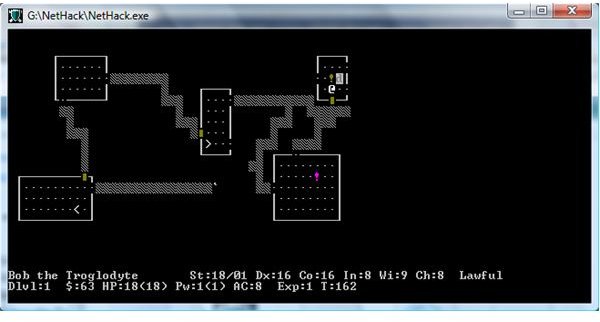The Classics: Text Based RPGs

Introduction
Some of the first computer games were RPGs, but hardware constraints at the time wouldn’t allow for complex graphics, and out of necessity these early RPGs had to be text based. The first text RPGs spawned a genre that is still surprisingly popular today. Many of them were inspired by Dungeons and Dragons, and this influence has been seen in computer RPGs ever since. If not the first, one of the earliest examples of a text based RPG is Dungeon, a D&D based game that first appeared in 1975. The game’s name was also it’s focus: the player’s party descended through a monster infested dungeon, collecting experience along the way.
Text Based Graphics
Many text based RPGs today are dungeon crawlers that use ASCII text to display dungeons and towns. Dungeon crawlers are usually more action and combat oriented, rather than story driven, and a large emphasis is placed on collecting loot and slaying monsters. Examples of this sort include Akalabeth (the precursor to the Ultima series), and roguelikes such as Angband and Nethack.
Popular RPGs that use text-based graphics:
Akalabeth (1979) - Created by Richard Garriott, Akalabeth (later re-labeled Ultima 0) used text based graphics to display the world. The Ultima series would help define computer RPGs as a genre. Like many early text RPGs, it was combat rather than story oriented.
Rogue (1980) - This is the game that inspired the term “roguelike”. Games of this sort usually involve dungeon-diving, and a focus on getting loot and killing enemies. They also typically include permanent character deaths, adding an extra layer of difficulty.
Nethack (1987) - Nethack is a roguelike that is still popular today, and is still in active development after 22 years, which is quite a feat for a free video game.
Angband (1990) - Angband is another roguelike, but it is set in J.R.R. Tolkien’s Middle Earth. Games of Angband can take long periods of time to complete, as the player must traverse a randomly generated 100 level dungeon in order to eventually defeat the evil Morgoth. Like Nethack, Angband is still being developed.
Ancient Domains of Mystery (1994) - ADOM, as it is often abbreviated, is a roguelike with strong emphasis on character and story development, which makes it unique in the genre, as most roguelikes are combat focused.
Similar Genres
The text adventure genre can at times blurr the line between adventure game and RPG. Early text adventures often employed fantasy elements and combat, but this genre tends to focus more on story rather than character development, which distinguishes it from role-playing games.
Early text adventure/RPGs:
Colossal Cave (1975) - This game spawned the adventure game genre. It was partially inspired by Dungeons and Dragons, which shows through in it’s RPG-like nature. The player’s surroundings are described in text, and the player types in commands in order to move or interact with the environment.
Zork (1980) - Zork is one of the most highly regarded interactive fiction games of all time, and it shares many elements in common with RPGs. The player is on a quest to explore a dungeon in order to collect treasures, and must avoid dangers such as the infamous Grue.
Text Based RPGs are here to stay
Text based RPGs, as a genre, are still alive and well, even in today’s age of graphically focused games. Computer RPGs started out as text based games, and there are many examples of the genre considered classics, such as the original Dungeon and Rogue. Even though the genres inspired by text-based RPGs, such as MMORPGs and adventure games, have become more popular, many gamers prefer to return to the basics every now and then, which is why games like Nethack are still popular, and will continue to be.
